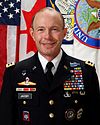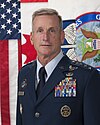United States Northern Command
| United States Northern Command | |
|---|---|
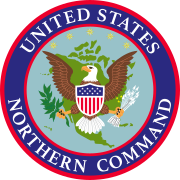 | |
| Founded | 1 October 2002 (22 years, 3 months ago)[1] |
| Country | |
| Type | Unified combatant command |
| Role | Geographic combatant command |
| Part of | United States Department of Defense |
| Headquarters | Peterson Space Force Base, Colorado Springs, Colorado, U.S. |
| Motto(s) | "We have the watch"[2] |
| Decorations | Joint Meritorious Unit Award |
| Website | northcom.mil |
| Commanders | |
| Commander | General Gregory M. Guillot, USAF[3] |
| Deputy Commander | Lieutenant General Thomas Carden Jr., USA[4] |
| Senior Enlisted Leader | CMSgt John G. Storms, USAF[5] |
| Insignia | |
| NATO Map Symbol[6][7] |  |
| United States Armed Forces |
|---|
 |
| Executive departments |
| Staff |
| Military departments |
| Military services |
| Command structure |
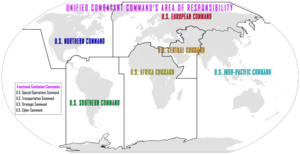
The United States Northern Command (USNORTHCOM)[8] is one of eleven unified combatant commands of the United States Department of Defense. The command is tasked with providing military support for non-military authorities in the U.S., and protecting the territory and national interests of the United States within the continental United States, Puerto Rico, Canada, Mexico, The Bahamas, and the air, land and sea approaches to these areas. It is the U.S. military command which, if applicable, would be the primary defender against an invasion of the U.S.
USNORTHCOM was created on 25 April 2002 when President George W. Bush approved a new Unified Command Plan, following the September 11 attacks. USNORTHCOM went operational on 1 October 2002.
Creation
USNORTHCOM was established on 25 April 2002 when President George W. Bush approved a new Unified Command Plan,[9][10] and attained initial operating capability on 1 October 2002.[11]
Mission
According to the UCP, Northern Command's mission is to:[12]
- Conduct operations to deter, prevent, and defeat threats and aggression aimed at the United States, its territories, and interests within the assigned area of responsibility and,
- As directed by the President or Secretary of Defense provide military assistance to non-military authorities including consequence management operations
Area of responsibility
USNORTHCOM's Area of Responsibility (AOR) includes air, land and sea approaches and encompasses the continental United States, Canada, Mexico and the surrounding water out to approximately 500 nautical miles (930 km). It also includes the Gulf of Mexico, the Straits of Florida, portions of the Caribbean region to include The Bahamas, Puerto Rico, the U.S. Virgin Islands, the British Virgin Islands, Bermuda, and the Turks and Caicos Islands.[13] The commander of USNORTHCOM is responsible for theater security cooperation with Canada, Mexico, and The Bahamas.[14] In May 2011, NORTHCOM was mobilized in the wake of the BP oil spill in the Gulf of Mexico[15] to provide air, ground, and logistical support.[16] In October 2014, NORTHCOM took administrative control of Alaskan Command.[17]
Organizational structure
Headquarters
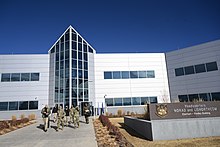
Commander, U.S. Northern Command is concurrently Commander of the U.S.-Canadian North American Aerospace Defense Command (NORAD). The two are co-located at Peterson Space Force Base in Colorado Springs, Colorado.[18] General Ralph Eberhart was the first CDRUSNORTHCOM.[19]
USNORTHCOM headquarters has approximately 1,200 uniformed and civilian staff.[20] In its first period of organising in 2002–03, one priority was to hire civilian staff which could help respond to a Weapons of Mass Destruction attack and to coordinate disaster recovery.[21]
Component commands
Subordinate unified commands
| Emblem | Command | Acronym | Commander | Established | Headquarters | Subordinate Commands |
|---|---|---|---|---|---|---|
 |
Alaskan Command[27] | ALCOM | Lt General Case Cunningham, USAF | 15 November 1945 | Joint Base Elmendorf-Richardson, Alaska |
There is no U.S. Navy component of ALCOM. The United States Coast Guard's 17th District works closely with ALCOM and de facto acts as its maritime component. |
 |
Special Operations Command North[28] | SOCNORTH | Colonel Matthew P. Tucker, USA | 5 November 2013 | Peterson Space Force Base, Colorado |
Standing joint task force
| Emblem | Command | Acronym | Commander | Established | Headquarters |
|---|---|---|---|---|---|
 |
Joint Force Headquarters National Capital Region | JFHQ-NCR | Major General Trevor J. Bredenkamp, USA | 22 September 2004 | Fort Lesley J. McNair, Washington D.C. |
 |
Joint Task Force – Civil Support | JTF-CS | Colonel Tanya S. McGonegal, ARNG | October 1999 | Joint Base Langley-Eustis, Virginia |
 |
Joint Task Force North | JTF-North | Major General Henry S. Dixon, ARNG | November 1989 | Fort Bliss, Texas |
Commanders
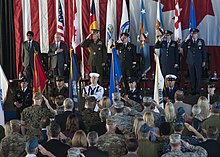
The commander of United States Northern Command is a four-star general or admiral in the United States Armed Forces who serves as the head of all U.S. military forces within the command's geographical area of responsibility. The commander of U.S. Northern Command concurrently serves as the commander of North American Aerospace Defense Command (NORAD) and is the head of all United States and Canadian joint aerospace military operational forces, stationed within the Northern American territories. The commander of U.S. Northern Command is nominated for appointment by the President of the United States and must be confirmed by the United States Senate. The commander of U.S. Northern Command typically serves for two years.
Note: The National Defense Authorization Act of 2008 stipulates that at least one deputy commander of USNORTHCOM be a National Guard general officer unless the commander is already such an officer.[29][30]
| No. | Commander | Term | Service branch | |||
|---|---|---|---|---|---|---|
| Portrait | Name | Took office | Left office | Term length | ||
| 1 | General Ralph E. Eberhart (born 1946) | 22 October 2002 | 5 November 2004 | 2 years, 14 days |  U.S. Air Force | |
| 2 | Admiral Timothy J. Keating (born 1948) | 5 November 2004 | 23 March 2007 | 2 years, 138 days |  U.S. Navy | |
| 3 | General Victor E. Renuart Jr. (born 1949) | 23 March 2007 | 19 May 2010 | 3 years, 57 days |  U.S. Air Force | |
| 4 | Admiral James A. Winnefeld Jr. (born 1956) | 19 May 2010 | 3 August 2011 | 1 year, 76 days |  U.S. Navy | |
| 5 | General Charles H. Jacoby Jr. (born 1954) | 3 August 2011 | 5 December 2014 | 3 years, 124 days |  U.S. Army | |
| 6 | Admiral William E. Gortney (born 1955) | 5 December 2014 | 13 May 2016 | 1 year, 160 days |  U.S. Navy | |
| 7 | General Lori J. Robinson (born 1958/1959) | 13 May 2016 | 24 May 2018 | 2 years, 11 days |  U.S. Air Force | |
| 8 | General Terrence J. O'Shaughnessy (born 1964/1965) | 24 May 2018 | 20 August 2020 | 2 years, 73 days |  U.S. Air Force | |
| 9 | General Glen D. VanHerck (born 1962) | 20 August 2020 | 5 February 2024 | 3 years, 169 days |  U.S. Air Force | |
| 10 | General Gregory M. Guillot | 5 February 2024 | Incumbent | 339 days |  U.S. Air Force | |
Planning and strategy
Northern Command has created several classified "concept plans" (e.g. "Defense Support of Civil Authorities") that are intended to address the 15 National Planning Scenarios that NORTHCOM must be prepared to respond to.[31]
However, in 2012, the GAO found that the national strategy to defend the United States is several years out of date.[32]
Domestic operations and training
NORTHCOM operates extensive domestic intelligence operations which both share and receive information from local, state and federal law enforcement agencies. Employees of the Federal Bureau of Investigation, Central Intelligence Agency, National Security Agency, Defense Intelligence Agency, National Geospatial-Intelligence Agency, and other agencies maintain offices at NORTHCOM and receive daily intelligence briefings.[33] The total of 14 agencies with representatives at NORTHCOM in December 2002 included the State Department, NASA, and the Federal Aviation Administration.[34]
Northern Command has completed several joint training exercises with local, state and federal law enforcement agencies, the Department of Homeland Security, and the Federal Emergency Management Agency (FEMA).[35]
In Exercise Vigilant Shield 2008, Northern Command, Pacific Command, the Department of Homeland Security, and numerous law enforcement agencies across the U.S. conducted exercises to test their "response abilities against a variety of potential threats".[35]
Related legislation
The Posse Comitatus Act of 1878 and subsequent Department of Defense policy constrains any member of the United States Army, Air Force, Navy, or Marine Corps, and the National Guard under federal authority from domestically intervening in a law enforcement capacity on United States soil. Several exceptions to the law have been used in the past, including protecting the citizens' constitutional rights in the absence of state and/or local assistance, such as protecting the Little Rock Nine students in Little Rock, Arkansas in 1957, and using the Insurrection Act to quell civil disorders, such as the 1992 Los Angeles riots.
The Military Commissions Act of 2006 lifted many restrictions placed on the military to support non-military authorities by the Posse Comitatus Act, however the United States Supreme Court ruled in June 2008 that significant portions of the MCA were unconstitutional. The "John Warner Defense Authorization Act of 2007" H.R. 5122 (2006) effectively nullified the limits of the Insurrection Act[36] when it was passed; however, the bill was amended in 2008.
On 1 October 2008, the 3rd Infantry Division's 1st Brigade Combat Team was assigned to U.S. Northern Command, marking the first time an active unit had been given a dedicated assignment to Northern Command. The force will be known for the first year as a CBRNE Consequence Management Response Force, and will serve as an on-call federal response force for terrorist attacks and other natural or manmade emergencies and disasters.[37]
See also
References
- ^ "NORTHCOM History" (PDF). NORTHCOM. Archived from the original (PDF) on 17 March 2022.
- ^ "USNORTHCOM Vision". Archived from the original on 7 November 2017. Retrieved 31 October 2017.
- ^ "Commander, North American Aerospace Defense Command and U.S. Northern Command". U.S. Northern Command. Retrieved 6 February 2024.
- ^ "Lieutenant General Thomas Carden, USA". U.S. Northern Command. Retrieved 11 May 2024.
- ^ "Command Senior Enlisted Leader, North American Aerospace Defense Command and U.S. Northern Command". U.S. Northern Command. Retrieved 15 June 2023.
- ^ FM 1-02 Operational Terms and Graphics (PDF). US Army. 21 September 2004. pp. 5–37.
- ^ ADP 1-02 Terms and Military Symbols (PDF). US Army. 14 August 2018. pp. 4–8.
- ^ Informally known simply as "NORTHCOM" or "Northern Command")
- ^ Whitley, Joe D.; et al., eds. (2009). "Unified Combatant Commands and USNORTHCOM". Homeland security: legal and policy issues. American Bar Association. ISBN 978-1-60442-462-1.
- ^ Bolkcom, Christopher; et al. (2005). "Homeland Security: Establishment and Implementation of Northern Command". In Thaler, William M.; Bea, Keith (eds.). Emerging issues in homeland security. Nova Publishers. p. 107. ISBN 978-1-59454-139-1.
- ^ Cecchine, Gary, ed. (2004). Triage for civil support: using military medical assets to respond to terrorist attacks. RAND Corporation. p. 25. ISBN 978-0-8330-3661-2.
- ^ "The Beginning" (PDF). U.S. Northern Command. 31 December 2012. p. 4.
U.S. Northern Command's mission is to deter, prevent and defeat threats and aggression aimed at the United States, its territories, and interests. Additionally, the command is charged with providing defense support for civil authorities when approved by the President or Secretary of Defense. U.S. Northern Command also provides military resources and support to federal, state and local authorities.
- ^ Jacoby, Charles. "2014 NC Posture Statement" (PDF). northcom.mil. Retrieved 18 April 2015.
- ^ U.S. Northern Command Public Affairs (22 October 2009). "About USNORTHCOM". USNORTHCOM website. Peterson Air Force Base, CO: U.S. Northern Command. Archived from the original on 16 August 2009. Retrieved 28 July 2010.
- ^ "USNORTHCOM responds to Deepwater Horizon oil spill". Northcom.mil. Retrieved 19 May 2011.
- ^ "Deepwater Horizon airspace activity now coordinated at 601st AOC". Northcom.mil. 13 July 2010. Retrieved 19 May 2011.
- ^ "NORTHCOM assumes oversight of Alaskan Command - Stripes".
- ^ Cutler, Thomas (2011). Navcivguide. Naval Institute Press. p. 59. ISBN 978-1-61251-019-4.
- ^ "U.S. Northern Command History". Retrieved 11 February 2013.
- ^ "U.S. Northern Command". Archived from the original on 16 August 2009. Retrieved 11 February 2013.
- ^ "New military command seeks civilian managers". 15 August 2002.
- ^ "ARNORTH Organization".
- ^ "MARFORCOM Units".
- ^ "Fleet Marine Force, Atlantic, Marine Forces Command, Marine Forces Northern Command". marforcom.marines.mil.
- ^ "US Navy Fleet Forces Command".
- ^ "1st Air Force Units".
- ^ "Joint Base Elmendorf-Richardson > Units > Alaskan Command".
- ^ "Special Operations Command North (SOCNORTH)".
- ^ http://www.govtrack.us/congress/bill.xpd?tab=main&bill=h110-4986 Pub.L. 110-181: National Defense Authorization Act for Fiscal Year 2008
- ^ http://www.govtrack.us/congress/billtext.xpd?bill=h110-4986 Pub.L. 110-181: National Defense Authorization Act for Fiscal Year 2008 full text
- ^ Wormuth, Christine E. & Witkowsky, Anne (2008). Managing the next domestic catastrophe: ready (or not)? : a beyond Goldwater-Nichols phase 4 report. CSIS. p. 47. ISBN 978-0-89206-534-9.
- ^ "DOD Needs to Address Gaps in Homeland Defense and Civil Support Guidance GAO-13-128, Oct 24, 2012."
- ^ Miller, Russell A. (2008). US national security, intelligence and democracy: from the Church Committee to the War on Terror. Taylor & Francis. p. 172. ISBN 978-0-415-44646-4.
- ^ Shenon and Schmitt NYT 2002.
- ^ a b Head, Michael & Mann, Scott (2009). Domestic deployment of the armed forces: military powers, law and human rights. Ashgate Publishing. p. 60. ISBN 978-0-7546-7346-0.
- ^ "Bush Moves Towards Martial Law, 26 October 2006". Towardfreedom.com. 26 October 2006. Retrieved 19 May 2011.
- ^ "Brigade homeland tours start 1 Oct". Army Times. 30 September 2008. Retrieved 19 May 2011.
Further reading
- Colonel Cronen; R. Barry (December 2009). "U.S. Northern Command & Defense Support of Civil Authorities". Center for Army Lessons Learned (CALL) Newsletter. 9 (10). Archived from the original on 16 May 2015. Retrieved 13 December 2011.
- Shenon, Philip; Eric Schmitt (27 December 2002). "Meeting Daily, U.S. Nerve Centre Prepares for Terrorists". The New York Times.
- NORTHCOM: A Short History Archived










